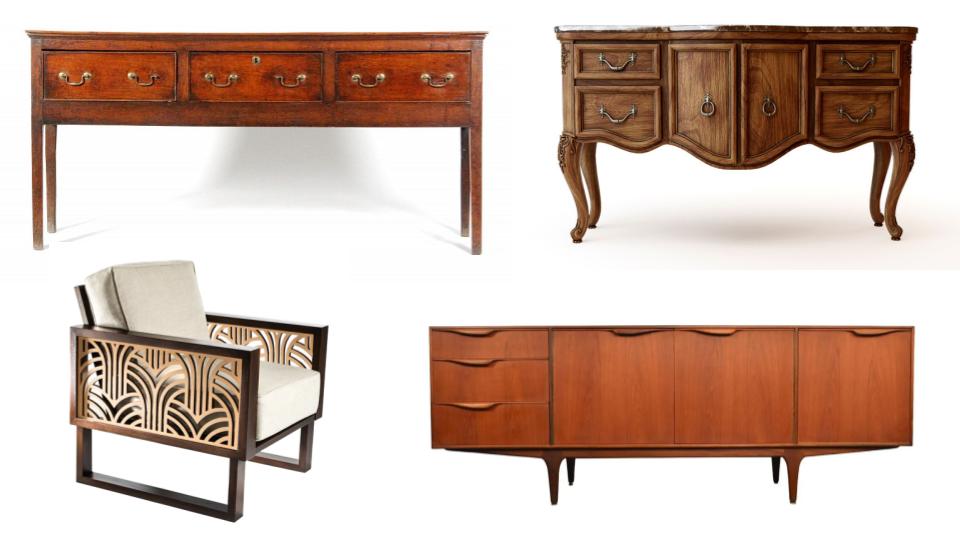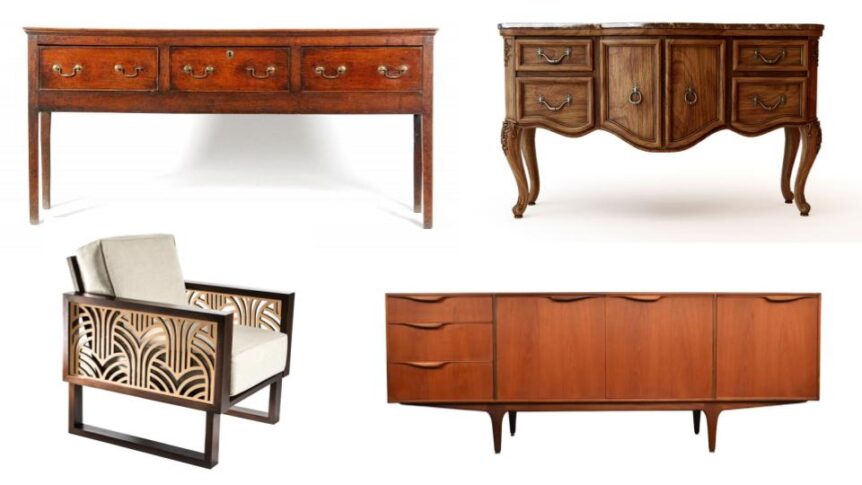Discover the key factors that make vintage furniture valuable and learn how to spot potential hidden treasures.

Vintage and antique furniture has become increasingly popular over the last couple of decades, with more and more people appreciating the history, quality craftsmanship and unique designs of old furniture. This demand has driven up prices for truly antique pieces as well as mid-century retro furniture from the 1950s-70s.
So how do you know if that old dresser you inherited from grandma or the retro sideboard you picked up at a garage sale is actually valuable?
There are several factors to consider when determining if a piece of vintage or antique furniture is worth money, which include age and era, brand names and markings, materials and construction, condition and repairs, styles and design features, and rarity and desirability.
By examining these aspects in detail, you’ll be able to identify valuable vintage and antique furniture pieces and distinguish them from simply old furniture. Let’s explore each of these value factors more closely.
What Makes Vintage Furniture Valuable?
Like with most antiques, the main factors that make vintage and antique furniture valuable include:
Age – The older a piece is, usually the more valuable it becomes, with 18th or 19th-century Georgian and Victorian pieces being most ideal. Mid-century furniture can also have value if it has a retro appeal.
Brand Names – Well-known, high-end antique furniture brands and designers are more collectible. Brand marks or labels increase value.
Materials – Solid wood furniture is far preferable over laminates and mediums like MDF. Exotic woods like mahogany and teak also command higher prices.
Condition – Furniture in excellent original or properly restored condition is ideal. Even minor damage and repairs can lower value if not done properly.
Rarity – Unique, one-of-a-kind, or scarce pieces tend to increase value for collectors as do special order customized pieces.
High Demand – Popular vintage styles like Art Deco, Danish mid-century modern and Art Nouveau have a strong collector following.
So you’ll want to look for furniture that is older, made by a reputable brand from the era, constructed from quality solid wood, displays excellent original or restored condition, and features a style that is currently in high demand amongst vintage furniture collectors.
Let’s explore each of these value factors in more detail:
Evaluate the Age and Era in Depth
A key to determining value is first identifying the general age and historical era your antique furniture was originally made and dates back to. This provides important context on rarity, styles, common brands from the time period, and typical materials and construction methods used.
Some specific eras known for higher quality antique furniture include:
- Georgian – Dates to 1714 to 1837 during the reign of the first four King Georges. Mahogany and walnut were prominently used. Features carved woods, ball and claw feet, and inlaid decorations.
- Victorian – Spans 1837 to 1901 during Queen Victoria’s reign. Rosewood and mahogany were common. Known for overstuffed ornate upholstery.
- Edwardian – Covers the years 1901 to 1910 under King Edward VII’s reign. Continued heavy ornamentation of the Victorians using mahogany, walnut, and oak.
- Art Deco – Popularized in the 1920s and 1930s based on geometric shapes. Used expensive veneers over quality joinery.
- Mid-Century Modern – Later 20th-century retro furniture from the Mid-Century Modern era of the late 40s through 60s is also valued by collectors. Mid-century often utilizes clean, minimalist lines and organic shapes. The older and rarer the piece, the higher the value.
Related articles:
- 10 Best Vintage Danish Furniture Brands of the 1960s and 1970s
- What Wood is Used for Mid-Century Modern Furniture?
- How to Identify Georgian Furniture (1714-1830)
- The Ultimate Guide To Vintage Bamboo Furniture
Look for Brand Marks and Names Extensively
Well-known vintage furniture brands and designers from past eras are a sign of quality craftsmanship and boost value. Some specific brands and designers to look for by era include:
- Georgian/Victorian – Gillows, Chippendale, Sheraton
- Edwardian – Harris Lebus, Harry & Sons, William Birch
- Art Deco – KEM Weber, Paul Frankl, Ruhlmann
- Mid-Century – Heywood-Wakefield, Knoll, Herman Miller, Isamu Noguchi
Look thoroughly around and under the piece with a flashlight for any label stickers, ink stamps, metal plates, or other markings that indicate the brand name. Matching the furniture style and details with the right prominent brand from that era helps authenticate it as an antique.
Examine Materials and Construction Thoroughly
The materials used and overall construction quality help determine antique furniture value. Things to inspect closely include:
- Solid Wood – Mahogany, oak, walnut, and teak are preferable. Avoid furniture made with particle board or cheap plywood.
- Handcrafted Joints – High-quality dovetail, mortise, and tenon joints indicate hand-crafted construction vs lower-quality machine-made furniture.
- Tenons – Protruding wooden peg-like ends from hand-cut joinery are a good sign.
- Veneers – Thin layers of exotic woods applied over quality solid wood frames are fine. But veneers over particle board are lower in quality.
- Inlays – Wood inlaid decor indicates extra time and skill went into the furniture.
- Markings – Manufacturer’s stamps, pencil marks, or labels in drawers or under surfaces increase value.
- Patina – Signs of natural wear and aging over decades adds character but avoid extreme damage or decay.
Related articles:
- 15 Best Vintage American Furniture Brands
- Why Mid-Century Modern Furniture Is So Popular
- How To Identify Mid-Century Modern Furniture
Assess the Condition Thoroughly
The condition and any repairs or damage also affects antique value:
- Original Finish – Natural patina is ideal. Refinishes can lower value but professional quality refinishing is acceptable.
- Structurally Sound – No loose joints, cracked wood, warped boards, or wobbly legs. Wood should be free from woodworm or other infestations.
- Working Parts – Drawers slide smoothly, doors open and close properly on hinges with no overhang.
- No Odors – Mildew, moldy fabric, or stale cigarette smells lower price.
- Upholstery Condition – Replaced upholstery reduces value, but properly re-upholstered antique furniture still brings decent pricing.
- Restoration Quality – Minor repairs ok if done properly and documented. Poorly done repairs or improper refinishing lowers value significantly.
- Wear and Tear – Some normal wear is expected with age. But excessive damage, stains, or missing pieces decrease price.
Previous repairs done meticulously and documented help maintain value. But major alterations replaced parts, and excessive damage or neglect can significantly lower resale value.
Identify Styles and Design Features
Vintage furniture design styles that are currently popular with collectors demand higher prices. Styles to look for include:
- Georgian – Mahogany woods, ornately hand-carved detailing, ball and claw feet
- Victorian – Overstuffed, large detailed pieces with lush fabrics and trims
- Art Nouveau – Flowing asymmetrical shapes, curved lines, nature themes
- Art Deco – Geometric patterns, exotic burl veneers, chrome or glass accents
- Mid-Century Modern – Clean simple lines, organic teak wood, molded plywood
- Danish Modern – Blonde teak, accentuate light natural wood grains
Rare and unique pieces featuring elaborate hand-carved details, marquetry inlaid wood designs, and other ornate craftsmanship also attract higher valuations.
Related articles:
Consider Rarity and Demand Extensively
Rare, one-of-a-kind antique furniture pieces and styles that are highly sought after bring top dollar. General factors affecting rarity include:
- Limited Production – Unique prototypes, custom one-off commissioned pieces, or short manufacturing runs.
- Uncommon Materials – Pairings like burled walnut with chrome or use of rare imported exotic woods.
- Short-Lived Styles – Distinct styles only prevalent in specific eras which makes intact pieces rarer.
- Regional Styles – Styles unique to certain locations like American East Coast Shaker furniture.
- Specific Brands – Makers that had limited output or no longer exist makes pieces harder to come by.
- Celebrity Ownership – Being owned by someone historically famous can increase interest dramatically.
- Signed Pieces – Those hand-signed or numbered as part of limited collections or editions.
In general, the finest quality antique furniture in excellent condition, made by prominent brands, featuring rare details and from popular bygone style eras offers maximum value potential. The very best pieces can fetch prices in the tens of thousands at fine antique auctions!
How to Estimate Your Vintage Furniture Value
Start by carefully identifying key details – brand, age, style, materials, and condition. Research styles and match markings to brands based on guides. Search similar sold prices of comparable pieces for value estimates. Consider hiring appraisers to inspect items thoroughly in person for the most accurate valuations.
Some general ballpark pricing ranges for good quality antique furniture in refinished or well-kept condition:
– Pre-1700s – $8,000 to $20,000+
– Georgian – $3,000 to $15,000
– Victorian – $1,500 to $10,000
– Edwardian – $800 to $7,000
– Art Deco – $1,500 to $7,500
– Mid-Century – $600 to $4,000
Pricing goes up significantly for rare, one-of-a-kind examples from prominent brands in excellent original condition. For example, a 1930s Paul Frankl ebonized desk with chrome accents in mint condition could easily auction for $15,000 to $25,000.
On the other hand, average quality furniture from the 1950s-70s often sells in the $500 to $2,000 range. Damaged pieces or low-end fixtures lacking in craftsmanship tend to max out around $300 to $600.
Key Takeaways on Vintage Furniture Value
The bottom line when evaluating old furniture:
- Seek pieces dating back ideally over 125 years for premium value
- Scrutinize for labels, plates, and markings to verify era-specific brands
- Inspect closely for solid woods, quality joinery, hand-crafted details
- Assess condition meticulously – minor wear is fine, but damage reduces the value
- Target currently popular vintage styles like Art Nouveau and Danish Modern
- Rare pieces and limited editions command top-tier pricing
Strongly consider professional appraisals for very old or rare high-end items. This will provide fair estimates of current market value based on an expert inspection of all the value factors covered above.
With some diligent research, inspection, and knowledge, you can identify truly valuable vintage furniture finds and realize their full value potential through optimal sales avenues.
Just be sure to thoroughly verify age, construction details, condition, brands, and styles when determining if your antique furniture is actually worth significant money in today’s vintage collecting marketplace.


